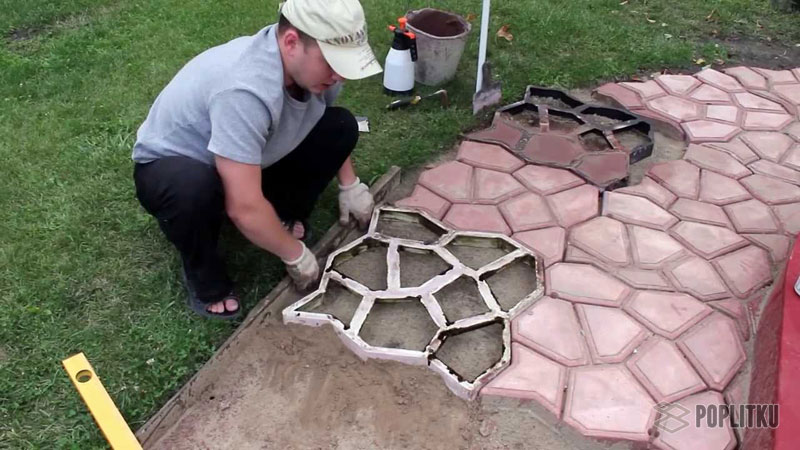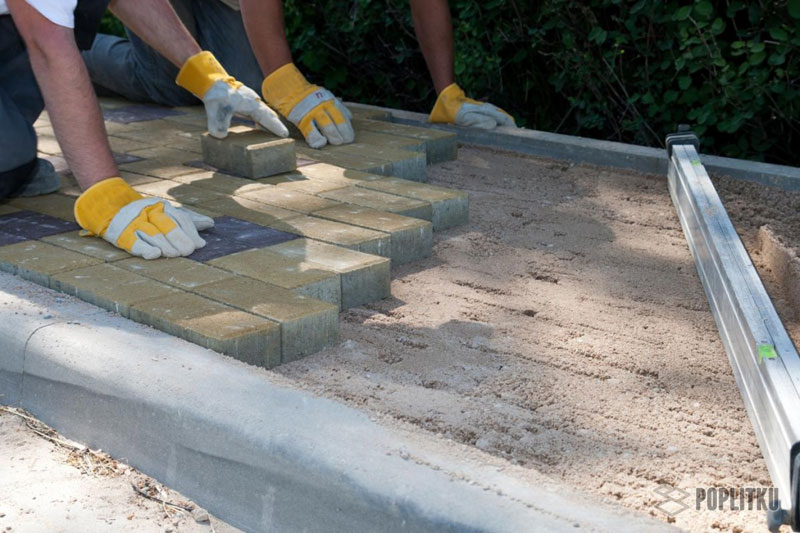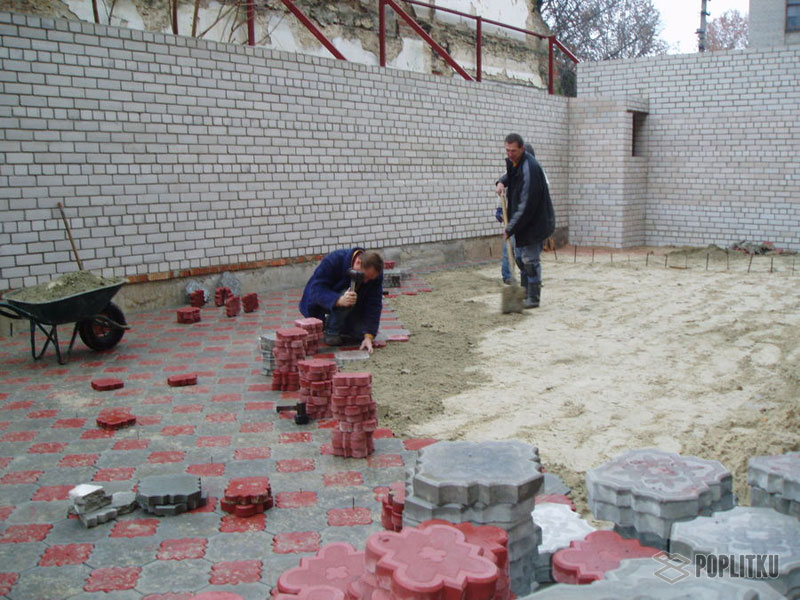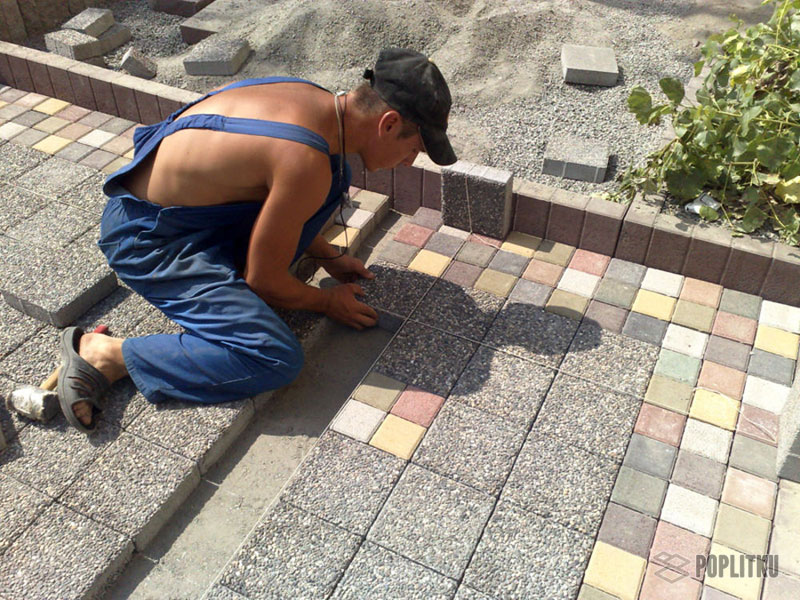How to lay paving slabs on sand and is it possible to do this?
Pavement tiles are made of durable material. In order for the product to last longer, it is necessary to correctly perform its installation. It is not necessary to invite specialists. Laying paving slabs on the sand can be done independently. Let's take a closer look at the workflow and technology features.
Styling technologies
In the independent manufacture of tiled material, two types of technology are used:
- vibrocompression. The molds are filled with mass, then compressed, vibrated under pressure. The finished product after removing the matrix is left to dry;
- vibration casting. The form with the solution is subjected to vibration, then dried.
A quality product is obtained if the proportions are observed and step-by-step instructions are followed. The finished tiled material will last more than one service life, if it is correctly laid.
What kind of sand is best?
The work on facing the tracks begins with the choice of the work surface. Before starting work, many faced the question of what kind of sand is needed for laying paving slabs. To choose the right one, follow these steps:
- pick up a handful of sand in your hand, then squeeze it;
- if the material is compressed into a lump, then it contains a lot of clay compounds and is not suitable for work;
- quality composition crumbly. After compression, it should easily pass through the fingers.
What kind of sand is needed for paving slabs is determined by eye. Just look at the bulk product. Its structure should be homogeneous, without lumps and clay compounds.
If you use a sand mixture in which clay is present, then during the operation of the tile material, small cracks will go along it. There should be no doubt which sand for paving slabs to choose - only high-quality and crumbly.
Which is the best sand to use for paving slabs depends on your skillful choice.
Laying on sand without cement
The most optimal technology for laying paving slabs on sand is without the use of cement mortar. Prepare the following tools:
- carpentry rubber or wooden hammer (mallet);
- rake;
- level;
- slats;
- brush with hard bristles.
Prepare your work surface. This stage of work should be treated with particular care. To properly lay paving slabs on the sand, you will need markings. To do this, drive in earthen pegs, then pull a cord between them.

To prevent weeds from growing between the joints of the tiled elements, the trench is pre-covered with geotextiles. Depending on the purpose of the laid path, the width of the protective layer is different. For pedestrian 15 cm, for parking much wider twice (30 cm).
The next step in the rules for laying paving slabs on sand:
- fill gravel, tamp;
- now it is the turn of the sandy structure (it is better to take a coarse-grained one);
- sand layer thickness 5 cm (minimum);
- the laid layer is leveled with a rail. Use level;
- tamp well, fill with water and leave to dry;
- the base is ready, now level the surface again.
So that tiled products do not go in different directions during operation, you need to protect them with borders. The level of the borders must match the tile level.
Tiled elements are laid out in the direction away from themselves or diagonally. To avoid deformation and destruction of tiles in cold weather, adhere to a slope of 2 degrees (for rainwater runoff). Below is a video on how to lay paving slabs on sand.

Facing work is not very difficult and you can do it yourself. The main thing in laying paving slabs is to fill your hand a little and follow simple rules at work:
- the first element is laid, pressed and carefully knocked out with a hammer;
- make sure that the parts do not move when laying (if necessary, add under the sand mixture);
- lay the next element, focusing on the level of the previous one. And so the whole workflow;
- gaps can be no more than 5 mm;
- if empty spaces remain, fill them with tiled particles (use a grinder to cut).
When laying paving slabs on the sand with your own hands is completed, fill the entire lined surface with a sand structure. With a brush, try to rub the sand particles into the gaps between the tile elements. You can use the lined track in the next day.
Lay on the ground without sand
In this part, we lay paving slabs with our own hands without using sand.
The ground surface will serve as the base. The method is considered to be very simple. This method is used in suburban areas, if the tiled elements themselves are large in size with imitation of natural stone.
Laying paving slabs on the ground without sand and preparing for work is practically the same as facing a sandy surface:
- a trench is being prepared;
- tile elements are compacted with a rubber mallet.
The only difference in laying paving slabs on the ground from the sand method is that the gaps after work must be covered with earth.
Ramming
How to put paving slabs on sand so that the lined surface lasts longer? Proper ramming is important. There are three methods:

These methods are suitable if you lay paving slabs on the sand yourself. The difference between rammers is in price and the area of the treated surface.
Techniques
There are several options for laying tiles in the country on sand and other surfaces:
- no need to prepare the base of several layers;
- if it is planned to update the overall design of the backyard territory.
Plan ahead
Before the main work on the lining of pedestrian or car paths, it is advisable to draw up a plan. The technology of laying tiles on sand in the drawings will look clearer. The diagram will clearly show how and where it is more profitable to place walking paths, whether elements for decoration will be needed.
The drawing is a plan for a dacha or a country cottage. Given the dimensions, you can calculate how much facing material is needed and what the base will be at the surface.
Check how well the drawing is made by walking around the site.
Basic Rules
How to put paving slabs on the sand so that there are no flaws? It is important to observe the following rules:
- the face of the tiled product must be level with the surface;
- be sure to use the level;
- if it is impossible to level the element with a hammer, lift it and level the base;
- you can not lay paving slabs on the sand in the rain;
- with uneven terrain, a concrete base is first constructed;
- sand must be free of impurities, roots and plant residues;
- the sandy base is suitable only for hiking trails;
- work is performed in the direction away from you;
- you can not use the tracks immediately after the completion of work.
The rules regarding how to lay paving slabs on sand are simple, but their implementation is mandatory. So the tracks will last a long time and do not need constant adjustment of the coating.
You can lay out paving slabs in the country on your own, guided by the rules and observing the technology. It is important to choose high-quality materials for work, to be attentive and patient.
If the tile material is also made independently, then a small expense will be obtained. Do not forget that in the question of whether it is possible to lay paving slabs on sand, the main thing is to patiently complete all stages of work.

To avoid unnecessary waste, plan in advance and calculate the required amount of material. Regardless of the base, paved paths can be used in a couple of days.
Keep track of the condition of the tiled coating during operation - it's easy. Can only be washed with water or detergents. Special, chemical agents are used in case of mold or rust stains.
In winter, be careful when cleaning tiles. Do not use pointed tools to avoid damaging the coating. Do not use saline solutions to reduce slip. Take only sand for these purposes.
When facing, try to make the slope of the tracks. So moisture will quickly leave the tiled surface. If the tile is laid for a platform for cars, then it is desirable to make the base for the cladding from concrete. The sand base is used on footpaths where heavy loads are excluded.



